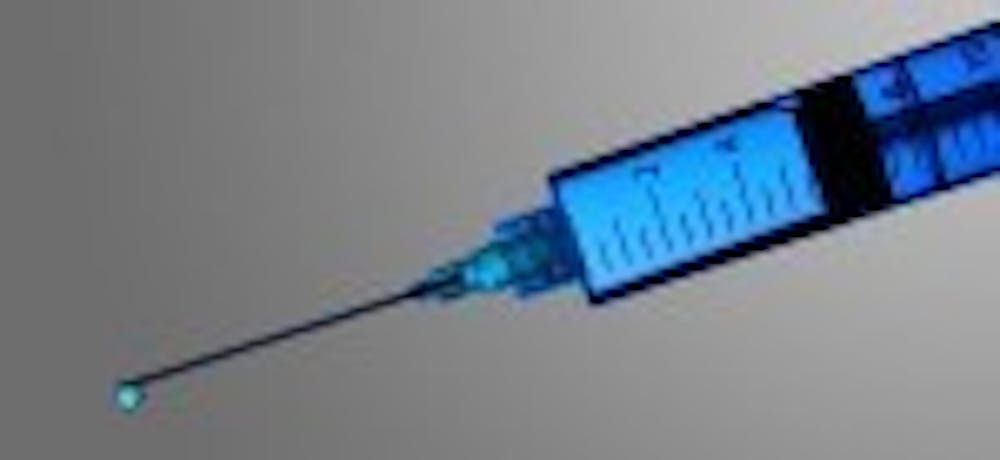UB is known as a research institution, but many students aren't aware of what professors are doing outside their classrooms. The Huffington Post used UB as an example of advances in scientific research, coinciding with innovative research and medical discoveries that have come out of UB in 2012.
Nano-shielding
Use: A protein that stops the body from attacking itself in autoimmune diseases
Researcher: Dr. Sathy Balu-Iyer, associate professor of pharmaceutical sciences
Pharmaceutical companies are currently developing protein-based medicines for the treatment of many diseases. The body often labels the treatments as foreign, causing an immune response and eventual rejection.
"When the immune reaction goes up then the efficacy goes down," Balu-Iyer said.
This occurs frequently after organ transplants and is seen in many chronic health problems. Balu-Iyer crafted a "reverse-vaccine" based off a molecule in the body. The vaccine was observed to almost eradicate the negative immune response by sending out a signal that influences the body to be tolerant of the therapy.
"So that is the most important thing... it fits into several biological processes," Balu-Iyer explained.
Balu-Iyer followed a mechanism the body uses on a regular basis: enzymes that use secondary mechanisms to mediate the immune system.
The treatment is different because it doesn't introduce any synthetic compounds or mechanisms to the body. Rather, it follows a process the body does naturally. As a result, the chance of complications is almost zero.
The mechanism doesn't compromise the body's immune reaction to other foreign antigens, because the nanoparticle is introduced along with the proposed treatment. It should be effective in treatment of hemophilia and other diseases in which the body attacks any proteins that are mutated and/or labeled as foreign.
There are several patents - for the mechanism and the use of the lipid - that are in the process of being completed. Balu-Iyer said the university plans to create a company that will stay in the Western New York area and manufacture products based on his discovery.
Tumor suppressors
Use: A mechanism to stop cancer cells from spreading to other organs
Researcher: Dr. Kate Rittenhouse-Olson, professor of biotechnical and clinical lab sciences
CD176 antigen is a carbohydrate on the outside of cells that aid in the spread of the cancer cells. JAA-F11 antibody binds to this antigen and blocks it. JAA-F11 is a monoclonal antibody made in mice.
Rittenhouse-Olson began work on these carcinogen-related antigens due to inspiration she found in her sister's fight with breast cancer. She recently founded For-Robin, a company dedicated to the specific use of JAA-F11 antibody in fighting breast cancer.
This antibody therapy may be used to treat cancer in any glandular tissues. When JAA-F11 is bound, spreading of the cancerous cells to the lungs can be blocked. This not only increases life span and the chance of survival, but the quality of life for patients.
Rittenhouse-Olson patented the use of JAA-F11 Antibody in 2008 and has since been committed to research with her company For-Robin, while her lab continues its work with development of a vaccine to the CD 176 antigen.
"It's more of a challenge to your body to make an immune response to a carbohydrate," Rittenhouse-Olson said. "We have to use more techniques to make it acceptable in a human body."
Within the next year, For-Robin plans on modifying the JAA-F11 antibody so that it can be used in patients with breast cancer.
Imaging Agents
Use: A compound that can be used in magnetic resonance imaging (MRI) for people who are allergic to contrast dye
Researcher: Dr. Janet Morrow, a professor of chemistry, Pavel Tsitovich, postdoctoral associate, and chemistry students Sarina Dorazio and Abiola Olatunde
Gadolinium is an expensive, rare earth metal, not naturally found in the human body that is currently used as a contrast dye with MRI. It's like calcium and most people can tolerate it; those who have kidney disease cannot handle gadolinium and MRI must be done without any contrast dye.
"MRI is used a lot but the problem is because you're looking at water and tissue, sometimes it's difficult to distinguish what's going on," Janet Morrow said. "So about 50 percent of the time, they add what's called a contrast agent, and that's what makes a tumor look different than the rest of the brain."
She is developing an iron-based contrast dye that is cheaper and works through a different mechanism than gadolinium - this naturally occurring metal won't be as damaging.
In Jan. 2010, Morrow met with other chemists, physicists and imagers in Torino, Italy to discuss Chemical Exchange Saturation Transfer imaging - a field of advanced medical diagnostics - and cultivate the development of medical imaging.
"If you have a brain tumor, they will give you gram quantities of gadolinium," Morrow said. "It's not naturally occurring, but they'll give you grams of it."
The new dye would allow for clearer imaging and more efficient treatment options in all patients. Because iron is found in the body, it can be easily recycled after it's used as an imager or continued as a "smart" compound - one that she said will "turn on and off, depending on conditions of the tissue."
Morrow is currently waiting for patents for her discovery while her lab is working to produce "smart" compounds, which change in the presence of heart disease, cancer or other markers.
Email: news@ubspectrum.com





